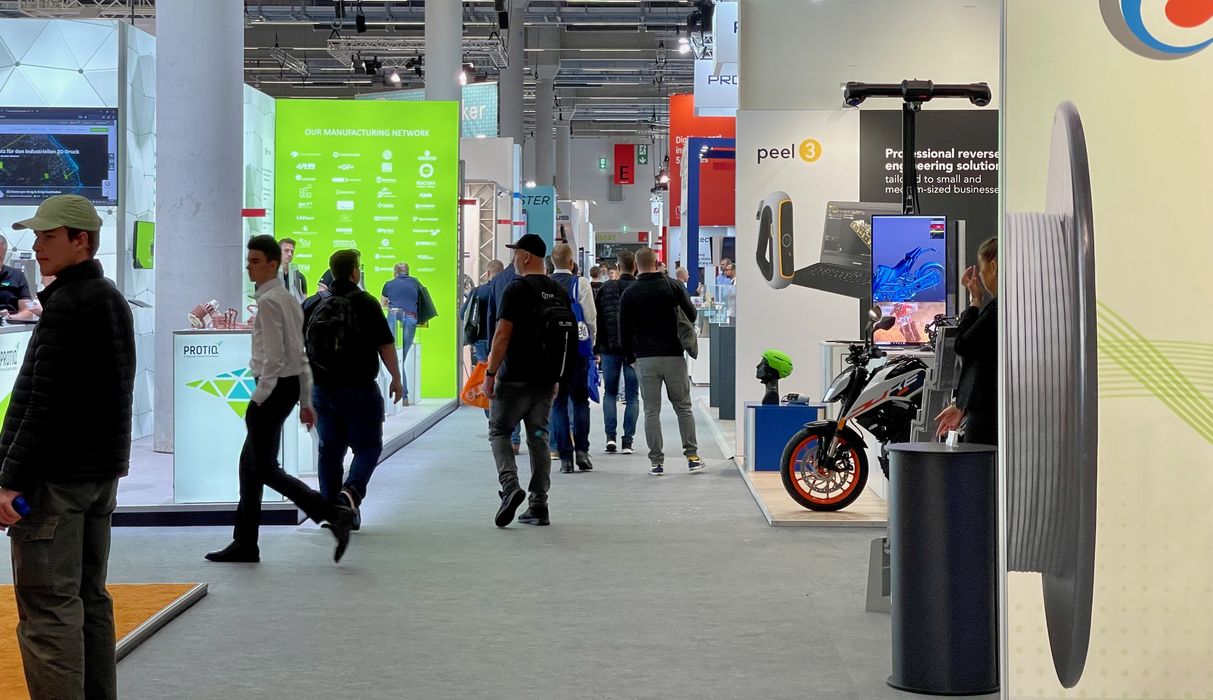
We’ve just returned from a busy week at Formnext 2023, and have plenty to say.
We spoke with a good chunk of the apparently 859 exhibitors at what’s billed as the world’s largest exhibition of 3D print technologies. And it’s true: there are no bigger 3D print events, anywhere.
The press was told the number of exhibitors has finally exceeded the pre-pandemic numbers of 2019, and that’s a good sign. However, we did notice that the floor area was noticeably smaller than in 2019, suggesting that the average stand size was quite a bit smaller than back then.
There’s clearly more recovery yet to happen.
While we are going to publish stories on our very lengthy findings over the next few weeks, I’d like to review several high level themes our team observed during the week that was Formnext 2023.
Absence and Size

As above, the event wasn’t quite as big as the organizers claimed. However, the reasons for that seem to be mostly financial. Several companies that had previously had large stands were either absent or had very tiny stands.
The reason could be that with the somewhat stalling of the technology in the manufacturing space, some companies that were fueled by investor cash may have found themselves in a tight spot.
One CEO told us that while there has been dramatically increased sales to the defense industry, it is not sufficient to make up for the decrease of business in other sectors. That’s obviously putting a lot of pressure on many 3D print companies.
Also note that bookings for the event basically happened two years ago, and back then things were quite different, pandemic-wise. It should be interesting to see how things change next year.
Room for Innovation

That said, there is still plenty of room for innovation. We observed many highly unusual 3D printing processes that hope to revolutionize the technology going forward. While some of the larger companies seem to be flat and less innovative, there are still many more up and comers.
Consolidation
In the past year there have been several high level corporate consolidations, with mergers ad acquisitions taking down the number of companies at play.
This was evident at Formnext 2023, where multiple stands had “another company’s products” squeezing in that had recently been acquired.
I have a suspicion there is going to be a lot more of this in the coming year.
Israel
There are plenty of 3D printing companies based in Israel, but some of them were missing from Formnext. Their absence was easily seen with huge areas completely empty in prime floor spots.
The situation in that country is well-known, and the individuals in those companies had to make choices. The story I most frequently heard was that while it was possible to get in and out of Israel even with diminished flights, some decided not to leave the country in case they might not be able to get back in should something bad happen.
That makes a great deal of sense to me, and I hope the situation is resolved quickly.
None of the Israeli companies we spoke with seemed to have any production issues due to the situation. Some have had a few military call-ups that they’ve had to deal with, but as far as manufacturing and shipping goes, it seems to be business as usual.
Sustainability
As in previous years, there is an ever-increasing emphasis on sustainability. We saw more materials made from recycled sources. Several companies indicated their industrial clients are almost always asking for sustainability aspects of equipment, materials and processes.
There were multiple companies showing methods of using scrap materials to produce usable 3D print feedstock, in both polymer and metal. It seems that metal powder in particular has been quite wasteful, and there are ways to solve that problem.
One twist relates to titanium. There were several ways seen to reuse that unusual metal, and it seems that it’s because the major source was Russia. That country is deservedly under severe international sanctions, making titanium a lot harder to source. Because of that there has been much increased interest in being able to recycle titanium for additive manufacturing.
Large Formats
Large format 3D printing was once a niche area, but that no longer seems to be the case. We saw many large-scale 3D printing systems using a variety of 3D printing processes.
There was a time when there was only a few large format vendors, and they made out quite well financially because of their uniqueness. That’s definitely not the case any longer. We saw metal, polymer, resin and robotic systems all producing massive objects. One desktop 3D printer manufacturer even produced a one-meter sized FFF 3D printer, for goodness sake. There were more machines printing furniture than I’d ever seen before.
It seems that this area has become much more competitive, and it may drive prices down.
Emphasis on Whole Lifecycle
While many 3D printer manufacturers still rely on the “build it they will come” strategy, there are an increasing number of smarter manufacturers that realize customers need help.
It turns out that 3D printing is a complex activity requiring training, experience, software, procedures and much more. Many companies have somehow found their way through that complexity to get operating in AM.
However, there are far more companies that don’t have the ability or patience to figure it all out themselves. Some 3D printer manufacturers realize this and are now packaging their wares in ways that make it far easier for prospects to participate.
For example, one company organized a kind of package of services that included software, materials, equipment, post processing and more that presented the customer with an easier buying experience.
Another company literally bundled all the required equipment into one physical box that could be purchased in one operation.
There were other variations, but the idea is the same: the customers that were able to figure out themselves have equipment. To access other customers, something different must be done.
Finally, there’s one more thing to say. In spite of our best efforts, we simply could not visit all the exhibitors we intended during the event. That tells you something about the size of the show when you can’t see everything even in four full days.
